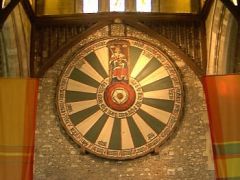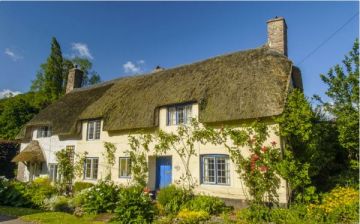King Arthur's Britain
Posted: 2009-06-27
Quite a few places in Britain have been associated with the legends of King Arthur since the Arthurian stories were first written down in the Middle Ages. Some of these places associated with Arthur have gained almost mystical status among those interested in the Arthurian legends. Here are some of the major British places which have been linked with Arthur and his knights.
- Glastonbury (Somerset) - the conical Tor is supposed to be the Isle of Avalon, where Arthur was taken when he died. There he is supposed to lie until he awakens in his nation's darkest hour to lead them again. In the Middle Ages, the monks of Glastonbury Abbey conveniently found bones in a grave with a slab inscribed with a Latin phrase which could be loosely translated as 'Here lies Arthur". The bones were reburied in the Abbey grounds, and labelled with a marker identifying them as the remains of Arthur and Queen Guinivere. At the foot of Glastonbury Tor is the Chalice Well, whose name is a reference to the Holy Grail, which Arthur and his knights sought.
- Tintagel (Cornwall) - perhaps the most popular Arthurian association beyond Glastonbury; Tintagel is alternately said to be the site of Arthur's birth, or the location of his castle of Camelot. The romantic remains of a medieval castle cling to the rocks above a rugged coastline, and it is perhaps the sheer drama of the location that makes the Arthurian link so enticing. One of the caves that line the shore is called Merlin's Cave after Arthur's mentor.
- Dozmary Pool (near Bodmin, Cornwall) - said to be the lake into which Sir Bedevere throws the sword Excalibur as Arthur lay dying after his final battle with Mordred.
- South Cadbury (Somerset) - Cadbury Castle is the name given to a high hill that rises above the village of South Cadbury. at the summit of the hill are the remains of an earthwork enclosure, or hill fort, said to be the site of King Arthur's Camelot. Excavations at Cadbury Castle suggest that it was occupied during the post-Roman era, possibly by Romanised Britons defending their territory against the invading Saxons. This gives some credence to the Arthurian connection, if you accept the premise that Arthur was in fact a leader of the Romanised Britons after the departure of the Romans.
- Winchester Castle (Hampshire - in the great hall of Winchester Castle a huge circular table hangs upon the wall. It is painted in twelve sections, and decorated with heraldic symbols. It is most likely that the table was created during the 13th century and repainted in Henry VIII's reign, probably in an attempt to link the Tudor monarch with the legendary king.
- Caerleon (Monmouthshire) - Geoffrey of Monmouth, writing in the 12th century, named Caerleon as the site of Arthur's court.
There are probably dozens of other, less well-known Arthurian sites about Britain, but these are the most popular.
More:
King Arthur on Britain Express
Caerleon and King Arthur - from the Caerleon town website
King Arthur and the Knights of the Round Table - a wonderful website for all things Arthurian
<< Britain's Best View - Pontcysyllte Aqueduct World Heritage Site >>
Attraction search



